#Nashi means pear in Japanese
Text

Design by 梨伊荼/Nashiicha(?*) winning the KEI award.
FUCK. Tumblr deleted my paragraph here… anyways. The design has no music or tech elements in it and I feel as if it’s lacking a lot. It’s a cool design but that’s all it stands on. It does not feel like Hatsune Miku. I went more in depth but fuck you tumblr.
I want to say some positive things before I end this and say I really like the accents on her clothes and her red eyes. Pops out. The way her hair is design and drawn is very appealing and probably took inspiration from KEI’s personal way of design. I have watched a video of him explaining how he thinks when he designs and when he design Miku. He had talked about filling in space and making it feel full and I think this design does that well. That is probably why KEI gave this design an award.
?* I’m not sure if I romanized the name correct, it seems the two last characters are only in Chinese. 梨 from my research means pear in both Japanese (NASHI) and Chinese(LÍ). The actual way to pronounce their username might be Lí Yī Chá (sorry I don’t know proper Chinese grammar) or Lí Yī Tó (IM SO SORRY AGAIN)
I am of Japanese descent but I am not fluent or familiar with my culture and I’ve only studied a little of Chinese so people correct and educate me if I had done anything wrong with my translation. It was a fun thing to do, I enjoy translation and hope to be translator one day.
#crypton future media#crypton vocaloid#cryptonloids#hatsune miku#vocaloid miku#miku#vocaloid#vocaloid hatsune#初音ミク#Hatsune miku if
9 notes
·
View notes
Text
Pecha Kucha
Seascape - Expression of time and layering experiment from 2nd year media worskhop for oil painting.

2. Pixelated White Out - Second year exmperimentation with photo glitchinbg applications.

3. Kao Nashi - Portrait of figure with a floating nashi pear. Inspired by Rene Magritte. Japanese pun meaning 'No face', as nashi also means 'none'.
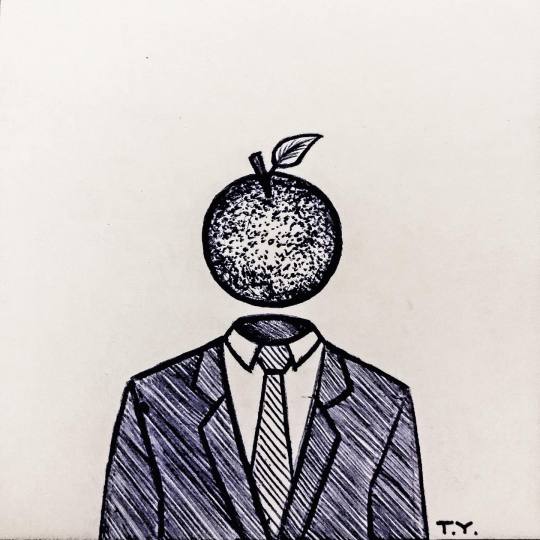
4. Inspector Blaze - Anthropromorphic portrait of flatmates dog Blaze the greyhound.

5. Perched on wood - Sculpture experimenting with material interaction.
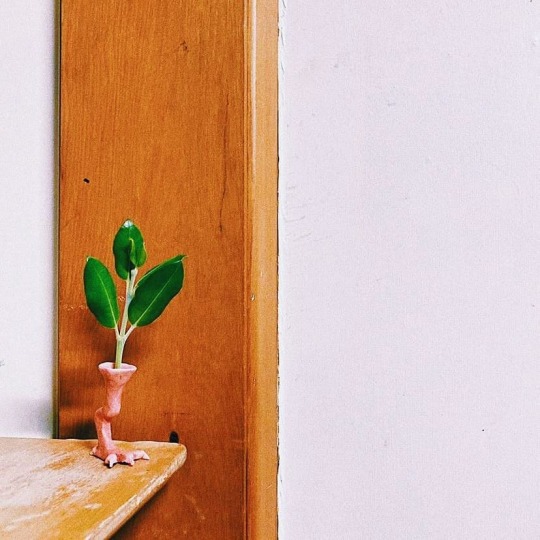
6. Kiganai - Scupture from third year, depicting a moment of isolation. 'Ki ga nai' directly translates to 'No trees', however also means 'Hoplessly dreaming'.

7. Brutal Stairs - Sculpture from third year exhibition 'I’ll get back to you'.
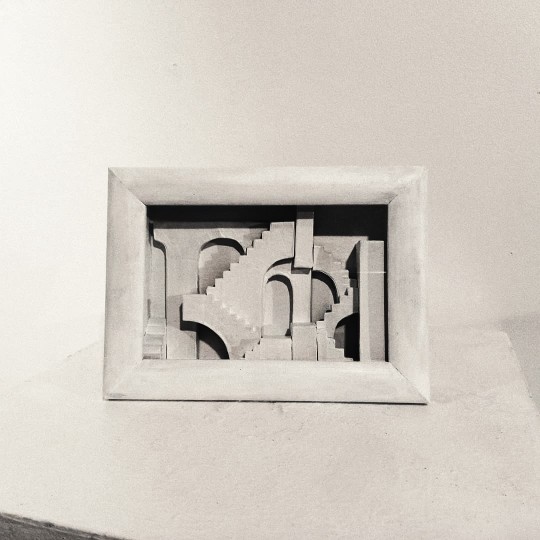
8. Perpetual Mise en Scene - Another sculpture from third year exhibition 'I’ll get back to you'.
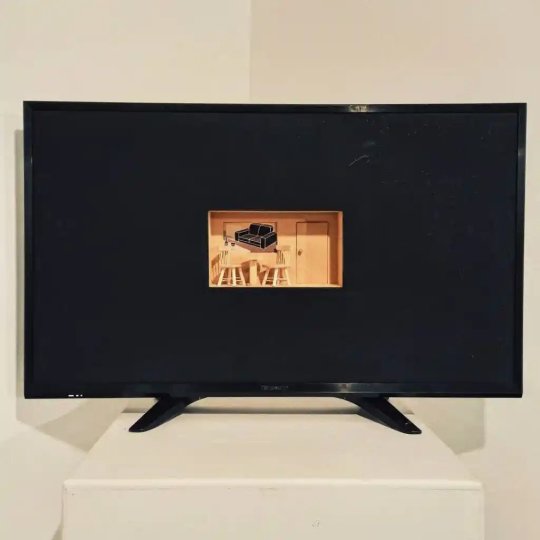
9. Conjunctive seating - Close up segment from Interior perspective drawing.

0 notes
Text
BNHA headcanon
Okay, so I know how Shinso has the whole thing with cats, but, but, think of this:
Shinso owning a pit bull.
He sees one in the shelter while he’s looking at the cats and he asks the shelter lady about him and she’s all like,”Yeah, unfortunately we get a lot of pit bulls here. Everyone thinks they’re all bad and dangerous just because they’re pit bulls, but most of them are actually really sweet, just like this little guy! His name’s Nashi!”
Shinso instantly falls in love and is like, “that one, I want it.”
He saves up enough money to get it and he also gets a job so he can pay for things like food and stuff.
Nashi gets along well with Shinso’s -and later Aizawa’s cats, so there’s no problem there. (At first the cats were a bit wary of him, but now they would hurt anything that dared try and hurt him.)
Once dorms are implemented, Shinso is heartbroken about having to leave his pets at home, but eventually they work out a strategy so that pets can come too, as long as they’re not a disturbance.
I like to think there’s a big courtyard in the middle of the dorms, which are shaped in some sort of a circle fashion, and people bring their pets there to hang out, like a dog park.
Most of the students with pets left them at home, because they were more family pets, but the ones who did bring pets quickly bonded in the courtyard.
Koda has plenty of pets, but some other pet owning students include Iida with his German Shepard that he insisted on bringing, because (according to him) his family would be busy with hero work all day, and Tensei couldn’t possibly give him the exercise he needs in a wheelchair, Setsuna Tokage with her giant lizard (no one really knows what breed it is other than her), Monoma and his ferret, Sero who has a bird that he’ll occasionally bring out, Yui Kodai who, while she may not seem like the type, has a python that she’ll bring to the courtyard sometimes, Ibara Shiozaki with a very large white cat that everyone is convinced is some breed of panther, and that’s not even counting all of the various cats and snakes and small rodents that people have that they don’t bring to the courtyard.
(Kirishima jokingly brings his pet rock along whenever his friends go to the courtyard to hang out since Kiri doesn’t have an actually pet, but don’t tell Coco that she’s just a rock, she doesn’t need to know.)
Nashi’s not much of a barker, so that was never a problem with the UA staff.
Although Shinso has a hard time sleeping most of the time, whenever it’s cold and Nashi sleeps right next to him, he falls right to sleep.
#headcanon#bnha#my hero academia#hitoshi shinsou#shinsou#tenya lida#setsuna tokage#neito monoma#hanta sero#ibara shiozaki#eijiro kirishima#Nashi means pear in Japanese#just thought I'd mention that#bnha headcanons
37 notes
·
View notes
Text
All yttd character name meanings cause I haven't posted on here in forever, long post lolz
Most of this taken from wiki
Beware of spoilers lol, I'll add my own personal notes about the name
Sara-> Sa meaning "(silk) gauze; gossamer" and Ra means "good; pleasing; skilled".
The Hebrew meaning for Sara means "princess/noble women" which is pretty fitting as she has the highest winning rate
Chidouin-> Chi "one thousand", Dou "shrine hall" and In "institution"
Jou-> "length; height"
Note that nankidai said that Jou's name originated from the line "stand up Joe!" From the manga "Ashita no Joe"
Joe isn't really a westernized version of Jou in yttd as vgperson states that both names are used in the source material, the name Joe is used in a more causal manner.
Tazuna-> ta "rice field" zuna "rope; cable"
Kazumi-> Kazu "peace" Mi "oneself"
Mishima-> Mi "three" Shima "island"
I think the island mightve been possible referencing how Mishima would be the first protagonist of your time to shine island existence. Could be just a coincidence though
Kai-> Kai "precept"
Satou- Sa "assistant; help" and Tou "wisteria"
Note that Kai also means shellfish (hence the "kain you believe it" surrounded by shellfish in his laptop) but Kai's name uses different Kanji from the shellfish one.
Alice-> his name is most likely a reference to the band "Alice in chains", since he is a man named Alice who is in chains. The German name Alice means "noble"
Yabusame-> ya "eight", bu "currency" and same "rain"
Reko-> re "waterway" ko "child"
Yabusame-> Ya "eight" Bu "currency" and Same "rain"
Note that her name was spelled as "Reco" but since C isn't really pronounced in the Japanese language, it later on got canonized to be "Reko" and "Reco" was used for her stage name.
Nao-> na "greens" o "cord, thread"
Egokoro-> e "picture" gokoro "heart"
Kanna-> Kan "god; deity" Na "what"
Note that there's also a flower that shares the same name as her
Kizuchi-> Ki "tree" zu "ferry" chi "pond"
Shin-> shin "truth; genuiness"
Tsukimi-> tsuki "moon" mi "see" (aka moon watching or moon viewing)
Qtaro-> Taro "strong, heroic, masculine"
Note that his name is a reference to a Jojo episode where a character uses the name "qtaro kujo"
Burgerburg-> this name dosent really have a meaning.
Qtaro's initials spell out bbq (BurgerBerg Qtaro)
Sou-> sou "suddenly; smoothly"
Keiji-> kei "respect" Ji "two"
Shinogi-> shino "bamboo grass" gi "tree"
Gin-> Gin "silver"
(I couldn't find the meaning for his last name rip)
Note that Sou is also an anagram for the Japanese word for lie, Uso
Hiyori-> hi "sun" yori "harmony"
Note that it can also be read as sunny weather
Midori just means green
Ranmaru-> Ran "orchid" Maru "circle"
Kageyama-> Kage "shadow" Yama "mountain"
Anzu-> An "apricot" Zu "child"
Kinashi-> Ki "tree" Nashi "pear tree"
Shunsuke-> Shun "excellent; genius" Suke "involve oneself; shellfish"
Hayasaka-> Haya "early; fast" Saka "slope; incline"
Naomichi-> nao "direct" Michi "road; path; route"
Kurumada-> kuruma "car" da "rice field"
Mai-> Mai "dance"
Tsurugi-> tsuru "crane (bird)" gi "castle"
Hinako-> Hina "chick" ko "child"
Mishuku-> Mi "honorable; beautiful" shuku "inn"
All of the floormasters have pun names
Sue miley-> smiley
Hoemi-> small smile
Tia safalin-> tears are a fallin
Han'naki-> half crying
Rio ranger-> rearrange
Rio lazier-> realizer
Toto noeru-> to arrange
Koko roeru-> to gain a heart
#yttd#joe tazuna#sara chidouin#kazumi mishima#kai satou#alice yabusame#reko yabusame#nao egokoro#kanna kizuchi#shin tsukimi#sou hiyori#yttd ranmaru#anzu kinashi#shunsuke hayasaka#naomichi kurumada#mai tsurugi#hinako mishuku#tia safalin#rio ranger#yttd spoilers
50 notes
·
View notes
Photo

okay so i don’t have non-awful raws for the new chapter yet but i absolutely needed to make a post about this pun because it makes me so fucking angry. i wanted to wait and see how they did it in the official english first, and that’s out now, so let’s go
marco’s attack is called 鳳梨の礫/nashi no tsubute.
first of all, this is a joke because its also just a japanese saying- 梨の礫/nashi no tsubute, (lit. ‘pebbles of/from a pear tree’) means to not get a reply, which is probably why i got an ask about one translation rendering this attack name as “passive flame.”
second of all, the word 鳳梨/houri, the main term here, reads literally as ‘phoenix pear tree.’
it’s an antiquated term for ‘pineapple.’
#jonny reads op#opspoilers#one piece#one piece spoilers#marco#kakekotobullshit#ch 998#op 998#japanese#arc: wano kuni
431 notes
·
View notes
Photo




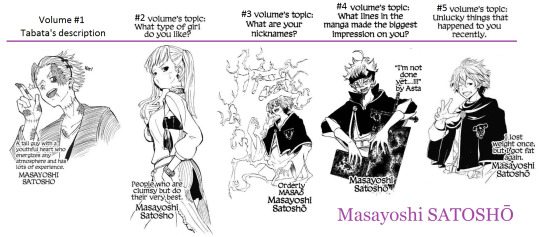
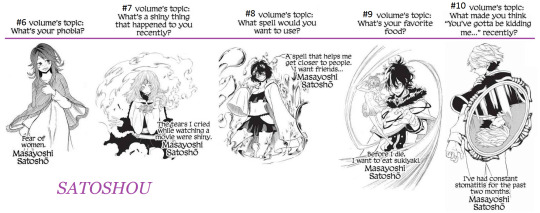

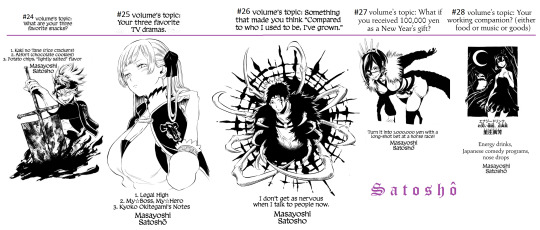

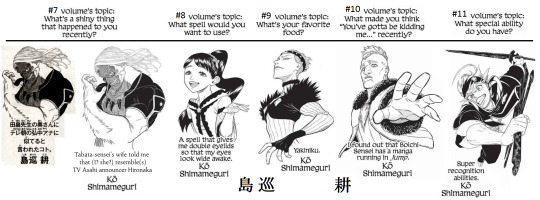
Blank Page Brigade Spotlight: Assistants (2/5)
Assistants Part 1 is: here
At the end of volumes of Black Clover is space for the "Blank Page Brigade." This particular "brigade" is composed of the assistants (you know, those who help with art) and others from the Black Clover manga team, lead by "Captain Tabata."
In Volume 1, Tabata gives a little description of his 6 assistants at the time. In subsequent volumes there's a question that everyone answers. Assistants also include a drawing with their answers. I've compiled the answers and drawings from all published volumes (1-29), and grouped them together.
4. Kouki ISHIKAWA - "A guy who is strapped for money, considerate, shy, cares about his siblings, and is both a breath of fresh air and sharp-tongued."
was present from vol.1-11, and again from vol.14-20
Ishikawa published a one-shot just this summer
drew Alecdora three times, and overall tended to draw side characters in these pages
Ishikawa has some of the wildest drawings of the original 6, I mean I don't even know where to begin so many are great - including some of the responses omg
so "really intense pear" or Gatsun, to Koi Nashi is actually a specific brand of ice cream
from vol.20: so "common hake" is a type of fish, and deep-fried bread again? the pictures for this one, seems like donuts right?
there was a hiccup in vol.20 where the vol.19 response was pasted again. I included the unobscured drawing from the Japanese scan next to it: it's banana Gueldre from the vol.7 drawing... smoking
can't believe Tabata describes Sakano as the weirdo meanwhile Ishikawa was just wildin out in most of the drawings hope that madlad is doing well
5. Masayoshi SATOSHŌ - "A tall guy with a youthful heart who energizes any atmosphere and has lots of experience."
was present from vol.1-10, went away, then came back from vol.19-28
Black Clover volume 10 was published March 2017, and according to MAL in April 2017 Satoshou started publishing "Momiji no Kisetsu." It was one volume, but then there's an alternative version by the same name that went on for two volumes in 2018.
Black Clover volume 18 was published in Nov 2018 and volume 19 in Jan 2019, which corresponds with the end of "Momiji no Kisetsu"
I didn't see Satoshou's name in the vol.29 pictures provided to me, so maybe he's gone out to give it another go? 🤔
many of the drawings for his replies don't use any gray tones, it's all just black ink. I wonder if Satoshou did dramatic shadows and idk inked?
I can't help but feel like that vol.22 reply was while working on "Momiji no Kisetsu"... 😨
also holy fuck about the vol.23 response 😱
vol.24 snack pictures: Kaki no Tane rice crackers, Alfort chocolate cookies
homie's out to gamble on them horses masa pls
vol.28 "Japanese comedy programs" was owarai bangumi which is apparently a specific type idk but wiki has a page about it [here]
6. Kou SHIMAMEGURI - "A kindhearted "heave-ho!" expert who often got carried away in the past. Draws background characters like nobody's business."
was present from vol.1-11
✨★✨ Background Characters Guy~!! ✨★✨
in what I assume to be Shimameguri's "self" I think they have ink magic? also I really like that hat :D
who's glasses is Julius holding? Shima's?
the last of the hiccups: after cleaning up the Vetto drawing in vol.7, apparently the text for Shima's reply was forgotten. I've included the Japanese scan next to it and even though I've asked, I'm still unsure who is the one being described as resembling Hironaka - and you know what I'm not gonna commit to either translation so there what? i can't read..
Assistants Part 3 is now here
#black clover#finral roulacase#gordon agrippa#zenon zogratis#alecdora sandler#black clover mars#lily aquaria#blank page brigade#long post#which is your fave ishikawa satoshou shimameguri drawing?#there's lil comics for the other vol.27-29 stuff#so the other parts may take longer
42 notes
·
View notes
Text
These Names Are Raining Hard Like the Storm from Earlier
(Case 5, part 6)

Maybe it's just me, but the way she says Susato is endearing.

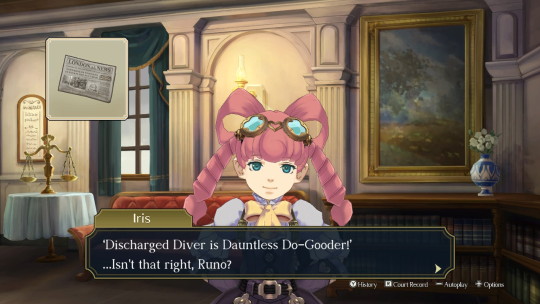
Localization Team Terrorizes Local Translator with Laudably Tactful Titles.

...Pop. They literally called the poor pawnbroker Pop. And his last name is Windibank.
Well, I get the pun. "Popping" something at a pawnbrokery is dropping it off there, presumably to get it back later. Also, he's a middle-aged man, so it's like calling him "Pops". But still. I thought it was brutal enough that his last name was "windy bank". I mean, sure, he's a bit round-ish, but saying he's a bank full of wind is a bit rude, you know. And now they straight popped him off. Like a balloon. He's dead. This is the British equivalent of "Deid Mann" I swear.
Well, to be fair, his name in Japanese was Hatch. I don't think it was specified what his last name was, or if that was his last name and they never gave his first. I thought it was pretty clever how it referenced a "hatch" as in Iris' cat flaps or the peephole, but it's also kinda like "hatchet" as in an axe... which in "give the hatchet" is also another way to say he's dead. Damn.

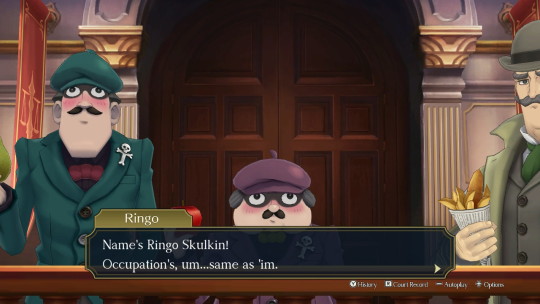
Now these names are a bit clever. Skulkin is clearly a play on "skulking", or sneaking around, since they're "profeshnal baddies". Nash is also a word in Edinburgh dialect meaning "to run, get away". It also sounds close to nashi, or Japanese for pear. Ringo is a reference to the famed Western outlaw Johnny Ringo. It's also the Japanese word for apple, ringo.
Btw, their names weren't based on their fruits in the JP version. They were Nemmy and Tally Tinpillar, where "Tinpillar" is a mutation of chinpira, meaning "hoodlum, thug". I think Nemmy is from the phrase nemimi ni mizu, which is literally "water in sleeping ears", an idiom meaning "a great surprise". Tally may be like in futari, meaning "two people", since he's usually the second one to respond. Or it could be like the grammatical suffix tari for continuous action, though it only applies to verbs, so I'm not sure there.

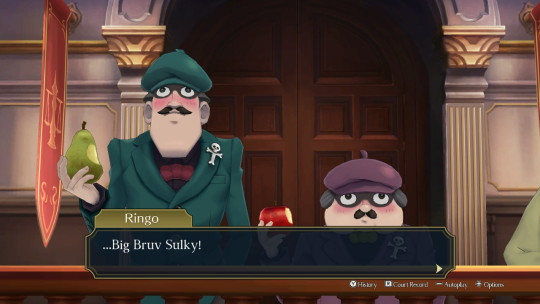
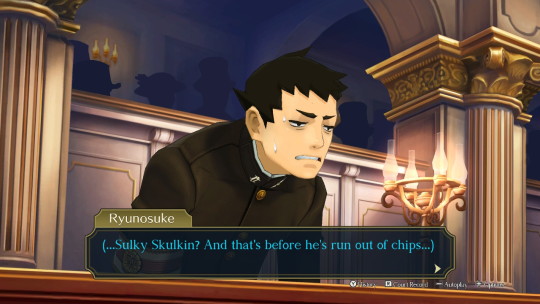
And in the JP, they call Gregson "Uze no aniki" or "Big Bruv Uze". Like "uzee", as in the slang version of uzai, meaning "annoying". Usually it's translated into a coarser swear in other more mature-rated mediums. Use your imagination.

Your Lordship, no! ...Well, actually yes, he is a little sulky. But poor Mr. Gregson. I actually like this guy, ya know.
--
I got plenty to cover tonight. Please be patient and tune in for more on my blog. Thankee.
25 notes
·
View notes
Text
Food and Drink Vocabulary in Okinawan
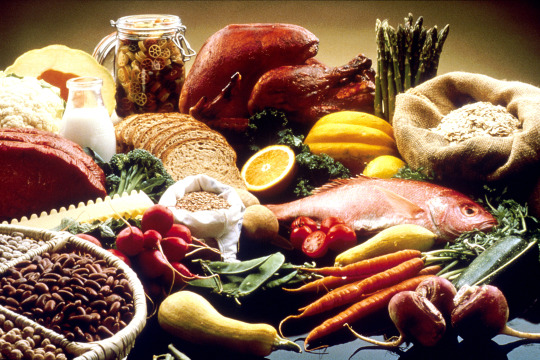
For this vocabulary list, I went through the book 小学英語絵カードプリント1400ブック and found the Okinawan equivalents for the Japanese words in that book. This covers the section of food and drink. Note that many words are identical to their Japanese equivalents. For words that I do not have confidence in (meaning they weren’t found in any dictionary but I used the Okinawan readings of the characters used in the word) are marked with a *.
Beef stew - ビーフシチュー・Biifu shichuu
Bibimbap - ビビンバ・Bibinba
Boxed Lunch/Bento - 弁当・びんとー・Bintoo
Buttered corn - バターコーン・bataa koon
Curry - カレー・Karee
Curry and rice - カレーライス・Karee raisu
Escargots - エスカルゴ・Esukarugo
Food - 物・むん・Mun
French fries - フライドポテト・Furaido poteto
Fried chicken - フライドチキン・Furaido chikin
*Fried Egg - 目玉焼ち・みだまやち・Midamayachi (might be目玉焼き・めだまやき・medamayaki)
Fried Rice - チャーハン・Chaahan
Gratin - グラタン・Guratan
Hamburger - ハンバーガー・Hanbaagaa
Hamburger Steak - ハンバーグステーキ・Hanbaagu suteeki
Hot Dog - ホットドッグ・Hotto doggu
Kebab - ケバブ・Kebabu
Kimchi - キムチ・Kimuchi
Miso Soup - 味噌汁・んすしる・Nsu shiru
Namul - ナムル・Namuru
Natto - 納豆・なっとう・Nattoo
Ramen - ラーメン・Raamen
Omlet - オムレツ・Omuretsu
Pancake - パンケーキ・Pankeeki
Paella - パエリア・Paeria
Peking duck - 北京ダック・ふぃきんダック・Fikin dakku
Piroshki - ピロシキ・Piroshiki
Pizza - ピザ・Piza
Rice ball - うぶんにじりー・Ubunnijirii
Rice cake - 餅・むち・Muchi
Salad - サラダ・Sarada
Sandwich - サンドイッチ・Sandoicchi
Soup - スープ・Suupu
Spaghetti - スパゲッティ・Supagetti
Steak - ステーキ・Suteeki
*Sukiyaki - すき焼き・すきやき・Sukiyaki (might be すち焼ち・すちやち・Suchiyachi)
Sushi - 寿司・すし・Sushi
Toast - トースト・Toosuto
Taco - タコス・Takosu
Sweets
Cake - ケーキ・Keeki
Candy - キャンディー・kyandii
Chocolate - チョコレート・Chokoreeto
Cookie - クッキー・Kukkii
Cotton candy - わたあめ・Wataame
Cream puff - シュークリーム・Shuu kuriimu
Crepe - クレープ・Kureepu
Cupcake - カップケーキ・Kappu keeki
Donut - ドーナツ・Doonatsu
Gum - ガム・Gamu
Ice cream - アイスクリーム・Aisu kuriimu
Jelly - ゼリー・Zerii
Parfait - パフェ・Pafe
Pie - パイ・Pai
Popcorn - ポップコーン・Poppukoon
Potato chips - ポテトチップス・Poteto chippusu
Pudding - プリン・Purin
Rice crackers - 煎餅・しんびー・Shinbii
Vegetables
Asparagus - アスパラガス・Asuparagasu
Beans - 豆・まーみ・Maami
Broccoli - ブロッコリ・Burokkori
Cabbage - キャベツ・Kyabetsu
Carrot - 黄大根・ちでーくに・Chideekuni
Cauliflower - カリフラワー・Karifurawaa
Celery - セロリ・Serori
*Chinese cabbage - 白菜・はくしぇー・Hakushee (might be 白菜・はくさい・Hakusai)
Corn - ぐすんとーぬちん・Gusuntoonuchin
Cucumber - 胡瓜・きーうい・Kiiui
Eggplant - なーしび・Naashibi
Garlic - ひる・Hiru
Ginger - しょーがー・Shoogaa
Green pepper - ピーマン・Piiman
Japanese radish - 大根・でーくに・Deekuni
*Leek; Onion - びら・Bira
Lettuce - レタス・Retasu
*Lotus root - れんこん・Renkon
Mushroom - 茸・ちぬく・Chinuku
Peas - いんどぅー豆・いんどぅーまーみ・Induumaami
Potato - じゃがんむ・Jaganmu
Pumpkin - ちんくゎー・Chinkwaa
Radish - ラディッシュ・Radisshu
Spinach - ほぅーりんな・Huurinna
Sweet potato - 芋・んむ・Nmu
Tomato - トマト・Tomato
Turnip - んんでぃー・Nndii
Vegetable - 野菜・やしぇー・Yashee
Fruits
Apple - りんご・Ringo
Avocado - アボカド・Abokado
Banana - バナナ・Banana
Blueberry - ブルーベリー・Buruuberii
Cherry - さくらんぼ・Sakuranbo
Chestnut - くり・Kuri
Coconut - ココナッツ・Kokonattsu
Fruit - 生物・ないむん・Naimun
Grape - ぶどー・Budoo
Grapefruit - グレープフルーツ・Gureepufuruutsu
Kiwi fruit - キウィ・Kiwi
Lemon - レモン・Remon
Mango - マンゴー・Mangoo
Melon - メロン・Meron
Orange - オレンジ・Orenji
Papaya - パパイヤー・Papaiyaa
Peach - 毛桃・きーむむ・Kiimumu
Pear - なし・Nashi
Persimmon - かき・Kaki
Pineapple - パイナップル・Painappuru
Strawberry - いちゅび・Ichubi
Tangerine - みかん・Mikan
Watermelon - しーくゎ・Shiikwa
Other food
Beef - 牛ぬ肉・うしぬしし・Ushinushishi
Bread - パン・Pan
Butter - バター・Bataa
Cheese - チーズ・Chiizu
Chicken - 鳥ぬ肉・Tuinushishi
Crab - がに・Gani
Croissant - クロワッサン・Kurowassan
Eel - んなじ・Nnaji
Egg - くーが・Kuuga
Fish - いゆ・Iyu
French bread - フランスパン・Furansu Pan
Ham - ハム・Hamu
Jam - ジャム・Jamu
Lobster - ロブスター・Robusutaa
Maple syrup - メープルシロップ
Naan - ナン・Nan
Octopus - たく・Taku
Pork - 豚ぬ肉・っわーぬしし・’waanushishi
Rice - 米・くみ・Kumi
Salmon - さけ・Sake
Sausage - ソーセージ・Sooseeji
Shrimp - いび・Ibi
Squid - いちゃ・Icha
Tuna - あちぬいゆ・Achinuiyu
Yogurt - ヨーグルト・Yooguruto
Drinks
Chocolate milk - チョコレートミルク・Chokoreeto miruku
Coffee - コーヒー・Koohii
Beer - ビール・Biiru
Cocoa - ココア・Kokoa
Cola - コラ・Kora
*Green tea - 緑茶・りょくちゃ・Ryokucha (Might be 緑茶・おーちゃー・Oochaa or something else).
Juice - ジュース・Juusu
Milk - 牛ぬ乳・うしぬちー・Ushinuchii
*Oolong tea - ウーロン茶・Uuroncha (might be ウーロン茶・Uuronchaa or something else)
Soda - ソーダ・Sooda
Tea - 茶・ちゃー・Chaa
Water - 水・みじ・Miji
Wine - ワイン・Wain
14 notes
·
View notes
Photo
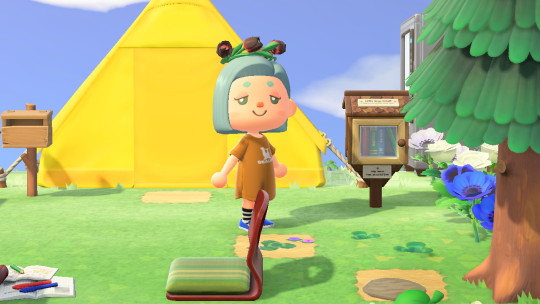

Meet Cinnamon’s new resident: Nashi! She’s going to be the owner of a little bookstore(once she has a house). Her name means pear in Japanese, Momo’s name means peach so I thought it would be cute to continue that theme.
#animal crossing#acnh#new horizons#animal crossing new horizons#ac new horizons#cinnamon#nashi#screenshots#passport#i need to fix her eyebrows lmao#she doesnt have the pro design editor yet
8 notes
·
View notes
Text
okay, so awkward story time
I went to Tottori (in Japan() yesterday (definitely recommend it, nice place) and I was at one of their souvineir shops. Now, one of the things Tottori is known for is their pears. This shop had pear ice cream so naturally I wanted pear ice cream. Now, I was supposed to ask for “Nashi” ice cream but I asked for “Nasu” (eggplant) ice cream. The woman didn’t skip a beat and asked “Did you mean Nashi ice cream?” I laughed awkwardly and said “Yep, Nasu would be weird wouldn’t it? Nashi ice cream please.” and then my awkward self couldn’t help it and added. “Nasu Nashi de.” (Without eggplant). The woman turned to her coworker briefly as she prepared my ice cream cone and said “He made a joke out of it.”
I mean, at least it was a play on words type of joke and showed some understanding of the Japanese language I guess but I;m still a tad embarrased. (yes, the whole conversation was in Japanese).
4 notes
·
View notes
Text

[V: I’ll Be a Hero Too] || BNHA AU
Younger twin brother to Sudachi Shirosaki ( @ivory-insanity ), Nashi is identical to him in nearly every way. When not using their quirks as children, they could be told apart by the shades of blue of their eyes with Nashi’s being a couple shades lighter. Even then, only the trained eye can spot the difference. Now, in high school, the differences have become a little more noticeable as Nashi has grown out his hair and dons a Shiketsu uniform. Unlike Sudachi, Nashi doesn’t usually transform his lizard eyes for the aesthetic of it, allowing his blue eyes to be seen. The exception to this being when he and Nashi are together in public, mostly as a means to mess with with people.
The most noticeable difference between them lies with their quirk. Where Sudachi is lean, fast, and nimble, Nashi is bulky, weighted, and tough. Sudachi’s strengths lie in speed and survey, him taking form after a blue tongued skink, whereas Nashi’s strength is in combative defense, taking form after an armadillo girdled lizard.
He goes by Shiro usually and often gets annoyed when people call him by his given name without permission. This is less because of Japanese social norms and more him not liking that Nashi is a homonym for a type of pear, a fruit he dislikes. He’s used to people calling him ‘Sudachi’ on occasion, and that doesn’t bother him nearly as much.
Nashi is an ambitious kid who wishes to become a hero, much like his older brother, however, rather than simply attending UA and following his brother around, he decided to take a different route. Enrolling in Shiketsu to step away from his brother’s side and grow as his own person, Nashi felt this path would be the best for him and Dachi to grow to their strongest potential rather than rely on each other as crutches for their weaker points (ie his lack of speed and Dachi’s lack of power).
More than a little anti social with a flippant personality to boot, Nashi has a hard time connecting with people. He’s well versed in studying his classmate’s quirks and analyzing his surroundings to build strategy. Though he knows his abilities have great potential in a team, his experiences with his brother proving this, and has potential to be an excellent coordinator, his personality and distance from his classmates impedes this greatly, try as he might to work around it.
2 notes
·
View notes
Text
[#Kanji of the Day] Tuesday November 7, 2017 (Heisei 29):梨果

Japanese Romaji: rika
Japanese Meaning: pome
Parts:
ri(nashi, rin) - a pear / pear tree
ka(ha, hata, kuda) - fruit / counter for pieces of fruit / achieve / carry out / complete / end / result / finish / reward / succeed / (Buddhism) phala (attained state, result) / (Buddhism) enlightenment (as the fruits of one's Buddhist practice)
----------------------------------------------------------
Chinese Pinyin: líguǒ
Chinese Meaning: pome
Parts:
lí - a pear / pear tree
guǒ - fruit of a plant / effect (in cause and effect) / result / fruit / consequence / indeed / really / truly / surely / exactly / if really / indeed / to stuff / to fill / succeed / resolute
*Note: two variants of the first character are 棃 and 梸. A variant of the second character is 菓, which is a separate character in Japanese
Kanji Count | Word Count: 2858 | 1792
10 notes
·
View notes
Photo

★ Aug. 8, 2017
Toraya, Tokyo: Mignardises Box
——–
A selection of the shop’s products. Each of these cakes is specially made in bite size, much smaller than its normal, regular-sized counterpart. (Red, jewel-shaped ‘kohaku(-kan)’ in the center is made exclusively for the 'Box’, having no counterpart in regular size.)
—-
Clockwise from upper left:
1) suisen*-iwao-no-hana (lit. narcissus*-at a large lofty rock-flower?)
2) pear caramel yokan
3) ao (blue)
4) ama-no-gawa (lit. river in heaven: Milky Way)
5) kuro-nashi (lit. black pear)
6) kokage-no-mizu (lit. water under [the shade of] a tree/trees)
7) sawabe-no-hotaru ([Japanese] firefly at the edge of a marsh/at the side of a stream?)
8) suika (watermelon)
——–
* 'Suisen (lit. narcissus)' can be used as a term that means 'made with kudzu/Japanese arrowroot.'
——–
#wagashi #japanesesweets #sweets #teaceremony #tea #chanoyu #sadou #japan #japanese #tokyo #スイーツ #和スイーツ #菓子 #お菓子 #和菓子 #お茶 #茶道 #とらや #ミニャルディーズ
#japanese#お菓子#和菓子#和スイーツ#茶道#japanesesweets#teaceremony#japan#tea#とらや#wagashi#chanoyu#ミニャルディーズ#お茶#スイーツ#tokyo#sweets#菓子#sadou
56 notes
·
View notes
Text
Current and Future Funassyi Events: Week of May 1, 2017

Here’s the latest roundup of Funassyi related events and so on. Check back every Monday (or close to it…) for a new update.
It’s Golden Week here in Japan, which means a lot of stuff is going on.
Funassyi 5 Year On Earth Anniversary Project
More details in in this post.
New 274ch official Instagram account
Link here
Live events/appearances by Funassyi
May 3: TOHOKU SMILE Day at the Rakuten Kobo Stadium (the home of the Rakuten Golden Eagles baseball team), Miyagi
May 6: Suga Fes at Saitama Super Arena (venue opens at 11:30 and is open until 21:00, show starts at 13:00). Unfortunately this seems to be sold out already...event site is here.
May 27: Mihara Satsuki Festival, Mihara, Hiroshima, 13:00 - 13:30 (site in Japanese)
May 28: Gotouchi Chara Festival in Sumida, Tokyo at the Tokyo Skytree and nearby venues (details in this post)
July 8-9: Friend Festival, Tomakomai, Hokkaido (event site; Facebook page)
July 28: Zepp Bushaa Tour at Zepp Sapporo - 274ch fan club members only event
August 2: Zepp Bushaa Tour at Zepp Nagoya - 274ch fan club members only event
August 11: Zepp Bushaa Tour at Zepp Osaka - 274ch fan club members only event
August 16: Zepp Bushaa Tour at Zepp Tokyo - 274ch fan club members only event
September 9-10: Gotouchi Chara Matsuri in Susaki, Kochi, Shikoku (details TBA)
Live events/appearances by Funagoro and/or Funyassyi
These are appearances by Funagoro and Funyassyi only.
Since there are Funagoro and Funyassyi fans too, I’ve listed all of their appearances here, so some may duplicate the listings above.
April 29: Funassyiland Harajuku at Kiddy Land - Funagoro and Funyassyi
May 4: Funassyi 5th Year On Earth Anniversary Exhibit, Seibu Department Store, Funabashi, 7th floor. 15:00 and 17:00 - Funagoro only
May 5: Funassyi 5th Year On Earth Anniversary Exhibit, Seibu Department Store, Funabashi, 7th floor. 11:00 and 13:00 - Funyassyi only
May 6: Funagoro’s Birthday Party at Funassyiland Funabashi - Funagoro only
May 27-28: Gotouchi Chara Festival in Sumida, Tokyo at the Tokyo Skytree and nearby venues (details in this post)
July 8-9: Tomakomai Chara Fes at Tomakomai, Hokkaido - all 3 Pear Fairies
July 6-9: 4 day / 3 night cruise Tomakomai Chara Fes Ferry Tour Funagoro and Funyassyi. (sold out, but details here)
274ch.com
274ch.com, Funassyi’s official streaming video channel/fan club, is the main outlet for Funassyi’s video appearances. Videos are uploaded every couple of days, and are very funny, with Funassyi appearing far more loose and relaxed than he is on broadcast TV. Highlights include a cooking show, Funassyi imitating various Japanese entertainers (his imitation of Beat Takeshi aka Takeshi Kitano is priceless), Funassyi going camping, Funassyi going go-cart racing, and much more. There are also frequent live streams of The Pear doing interviews and so on.
There are also fan-exclusive meets with Funassyi, and fan-exclusive concerts too, such as the upcoming Zetsu Bushaa Tour (see schedule above).
Membership is 600 yen per month or 6,000 yen per year. You can now join from outside of Japan too, although the site is in Japanese only (and so is customer support and so on). Details here. You will most likely need a Japanese mailing address to receive materials from the site for now.
Note: Sometimes someone at the streaming video provider seems to turn on IP checking/blocking of non-Japanese IPs. If you can’t access the videos, just wait a few hours and it will usually get fixed.
TV, Radio, Live Webcasts, Movies, Music
Music - Available for preorder: Spring 2017 Ketsugobou Tour DVD (release date: May 26). 274ch member order page. Also available from CDJapan, Amazon Japan, Funassyiland web store.
May 3: Movie - Last Cop: The Movie opens in Shochiku theaters around Japan. Funassyi has a key role. (details)
May 4: TV - Vs. Arashi, Fuji TV, 19:00~19:57, as part of Team Kojima
Online - Available for viewing now : Untouchable Shibata’s Animal Research Team program in 4 parts on 360.tv (details)
Music - Funassyi has new song called The Pear That Walks (Aruku Nashi - 歩く梨), which he’s been performing with the “Heavy Metal Chara Band” (photo above) at the Spring Butt Burdock Root concerts. We should be able to see it finally on the upcoming DVD release!
Special shopping events and exhibitions, restaurants etc.
April 29 - May 8: Funassyi 5th Year On Earth Anniversary Project exhibit at Seibu Department Store, Funabashi (see 5th Year Anniversary Project above)
April 29 - May 21: Limited period Funassyiland at Omiya Loft store inside Sogo Department Store, Omiya Saitama-shi, Saitama (details)
Sometime in the summer: Funassyi livery train, Shin Keisei Railway (details TBA)
Funassyi ‘gacha’ bonuses for a limited time in the Alien’s Egg game (Japan only) (details)
Available now: Funassyi stickers for iMessage (the Messages app), iOS only - but available worldwide! (link to US App Store - check your local App store)
Available now : Minna de Aemen Funassyi themed noodles from Yamasa
Available now: Taiwan/Chinese version Funassyi LINE stamps (check in your LINE app; not available outside of Taiwan though)
Photo source - Funassyi with his alter ago Bunassyi, from the movie Last Cop, which opens this Wednesday.
6 notes
·
View notes
Text
Wandlore
from The Encyclopedia of Wands
The wand is a European invention; wandlore was primarily introduced to Japan when American witches and wizards entered the country in the mid 19th century. Although Japanese magic practitioners have known about the existence and usage of wands since the early days of contact with foreigners, they were not adopted into common usage until the early 1910s.
Japanese craftsmen took up the challenge of learning wandlore abroad and later returned to tailor the wand to suit Japanese practitioners. As a result of the unavailability of several materials, such as two out of the three recommended wand cores, these craftsmen were forced to experiment with different woods and cores.
Wand prices are regulated by the three families still in the business, all of whom inhabit a single street in wizarding Kyōto. Because woods from trees cultivated abroad may be difficult to match to an owner, all materials are grown in-country.
Cores and differences between woods found in Japan and Europe will be covered in this post. The woods specific to Japan are listed here, but each has its own entry in a separate post.
Cores
Dragon heartstring- Most of these cores are obtained from dragons of Japanese, Chinese, or Korean origin. The Japanese species have heavy associations with water and favor this element of magic over all others. They are powerful just like their European cousins, but are also dangerous and even vengeful when wronged.
Firebird feather- It is important to note that the firebird is very different from the Western phoenix despite several superficial similarities. Like phoenix feather cores, the firebird feather is also very picky about its owners. It is extremely intolerant of the Dark Arts.
Fox spirit hair- A very tricky core that is not suited for most witches and wizards. It is somewhat weaker than other cores, but produces excellent disillusionment charms and excels at transfiguration. They may impart the ability to understand the language of beasts to a select few.
Lion-dog hair- The komainu or shishi is a protector, a guardian of shrines that wards off evil spirits. They are capable of very consistent and reliable magic.
Wolf hair- The Japanese wolf is believed to be a protector and a messenger of the kami by rewarding good deeds, punishing evil, and even warning villages of disaster. Although there are few left (the non-magical think it to be extinct), every now and again one will donate a few hairs. These cores, like the creature they come from, have some prophetic qualities.
Crane feather- The feather of a crane is less potent than a firebird feather, but far easier to obtain. They produce elegant spells and tend to perform well in proportion to the effort put forth by the wielder.
Woods
All known woods in the HP verse, as well as a few Japan-specific additions, are listed. The ones that are not available in Japan are marked as imports, but because imported wands are costly, almost all Japanese magic users get their wands in Japan.
Only new additions receive a dedicated entry in another post. The rest that overlap with HP canon have notes indicating how that wood is relevant to Japanese culture. It’s difficult thinking of wand wood descriptions, so I’ll leave it at that.
I theorize that some of the woods have different properties because most woods have species native to Japan (or China). It’s reasonable to assume a plant native only to Europe or the Americas would perform differently from one found only in Asia.
Acacia: Import.
Alder (hannoki): Used to restore devastated land.
Apple (ringo): A common wood in Japan.
Ash (aodamo): The name refers to 1) the blue color that water appears after ash wood is submerged in it, or 2) the wood’s use in dyes.
Aspen (yamanarashi/hakoyanagi): A hardy wood, tolerates long winters.
Beech (inubuna/buna): Japanese blue beech.
Birch (mizume): Japanese cherry birch.
Blackthorn: Import.
Black Walnut: Import.
Cedar (sugi): Japanese cedar has religious significance. Often planted around temples and shrines. Said to connect heaven and earth, and be the vehicle by which kami descend.
Cherry (sakura): A symbol of humility, transience, mortality, and mono no aware (embodiment of impermanence). Some are hailed as sacred trees. They symbol new beginnings. Common in Japan.
Cypress (hinoki): Sacred trees used to construct shrines and conduct Shintō rituals. It takes hundreds of years to grow to a great size, so extremely well quality cypress wood is exorbitant in price.
Dogwood (yamabōshi): Japanese dogwood is a symbol of delicate beauty and means friendship in the language of flowers; the kōsa dogwood variety adds toughness.
Ebony (kakinoki): Wood from the persimmon tree. Has healing properties. Relatively rare.
English Oak: Import.
Elm (harenire): A graceful tree that is green well into autumn. Rare, as most of its habitat has been lost to rice cultivation.
Fir (urajiromomi): Resistant to air pollution.
Hawthorn (sanzashi): Used in traditional medicine.
Hazel (hashibami): Represents one of the traditional colors of Japan.
Holly (tarayō/hiiragi/inutsuge): There are many different types of holly. see here for the hiiragi variant
Hornbeam (kumashide/katashide)
Larch (karamatsu)
Laurel (aoki): Thrives in the most difficult of garden environments, dry shade.
Maple (kaede): entry
Paulownia (kiri): entry
Pear (nashi): Given as gifts and served to guests.
Pine (kuromatsu): Japanese black pine is resistant to air pollution and salt. Requires many years to train properly for bonsai.
Plum blossom (ume): entry
Poplar: same as aspen
Red Oak: Import.
Redwood: Import.
Rosewood: Import.
Rowan (nanakamado): A sturdy firewood, does not get entirely consumed by the fire of a stove even after repeated use. Its name means “seven times in a stove”.
Sakaki: entry
Silver Lime: Import.
Spruce: Has various names, some more rare than others.
Sycamore: Import.
Vine: The vines of several types of trees may be used.
Walnut: Import.
Willow (yanagi): Associated with ghosts.
Wisteria (fuji): entry
Yew (ichii)
It is inadvisable to speed up the growth of these trees with magic; it is known to interfere with the tree’s natural properties.
18 notes
·
View notes
Text
Fuji to Hood at Culmination Brewing
Starting at 12 pm, on the 21st of April, The Bindery Annex and Culmination brewery will host Fuji to Hood. As one of the more unique events in Portland, this will be an opportunity to sample sushi from Bamboo Sushi, ramen from Marukin Ramen, while sipping on beers (and one cider) imagined by breweries (and one cidery) from both Portland and Japan. Those who would prefer something more 'festive' are welcome to enjoy Oregon's SakéOne at no additional cost.
Fuji to Hood will be held Saturday, April 21st, 2018 from Noon to 4pm at the The Bindery Annex and Culmination Brewing. More info and tickets at FujitoHood.com. The Fuji to Hood festival is brought to you by Culmination Brewing, Mecca Grade Malt, Travel Portland, Oregon Hop Commission, Oregon Fruit Products, SakeOne and JASO (Japan-America Society of Oregon).
With tickets on sale, this even will undoubtedly sell out before too long. Those who signup will be given a limited-edition, "Fuji to Hood" branded glass, as well as 12 tickets good towards 4 ounce samples of beer.
More on the beers (and cider)
Breakside Brewery/Far Yeast Brewing: Sweet Osmanthus Saison
Classic saison with a kiss of Citra hops and liberal use of kinmokusei or sweet osmanthus, a flower often used in white tea blends. 5.9% ABV 25 IBU
Burnside Brewing Co./Yokosuka Brewing: "Who's Umami?" (savory London Porter)
In the true umami tradition a broth with 25#s of Japanese shitake powder was blended at a controlled temp of 80 degrees and held for 9 hours before being infused with the mash the following morning. Approx 25#s of additional powder was added to the end of the boil to create a delicate savory flavor to complement the layers of malt complexity. Subtle additions of noble hops round out this "appealing to the senses" ale. (ABU, 5.8%--IBU, 21)
Cascade Brewing/Y.Market Brewing: Shiso Sour Red Basil Ale
A blend of sour wheat and triple ales aged in oak wine barrels for up to two years with fermented red shiso leaves and fresh red basil. 7.5% abv and 9 or less IBU’s.
Culmination Brewing/Ise Kadoya Brewing: Oishi Nashi
Oishi Nashi means Beautiful Pear in Japanese. The beer is an East Asian Pear Grisette using a proprietary yeast strain from Ise Kadoya brewery in Japan. The yeast was originally isolated from the sap of a tree in a Shinto shrine garden in Kadoya, Japan. This Grisette-style ale was also brewed with Asian Pear juice. 4.8%
Ecliptic Brewing/Heiwa Shuzou: Shi Shi Saison
Named after the constellation Leo the Lion, Shi Shi Saison was brewed with Sansho Japanese Green Peppercorns and Yuzu peel imparting flavors of citrus that perfectly complement the Belgian yeast character. ABV 6.8 IBU 20
Ex Novo Brewing/Rise & Win: Going Postal Citrus Sour
A hoppy sour with Japanese Yoko citrus, Indigo leaves, and Citra, Amarillo, and Simcoe hops. ABV: 5.4% IBU: 46
Gigantic Brewing/Harvest Moon Brewing: Oni Kawaii
Kettle soured beer with black rice and marionberries. This beer is pink from the colors of black rice and purple berries. (We made it pink with black rice!). 4.2% abv. Oni Kawaii!!!!
Hopworks Urban Brewery/Nihonbashi Brewing: Hinoki Lager
a sake inspired rice lager brewed with the lees of the sake making process called Sake Kasu. After 3 weeks of lagering the beer was then conditioned on Japanese Cypress Chips to give it the aroma of traditional masu drinking boxes. 5% abv.
Reverend Nat’s Hard Cider/Son of the Smith Hard Cider: Yaoyorozu, aka 8 Million
This cider started as wild yeast harvested from multiple orchards in Nagano, Japan, by orchardists and cidermakers Son of the Smith, shipped live and active to Reverend Nat’s in Portland. In Portland Nat’s inoculated a blend of Japanese-origin apple varieties such as Fuji, Akane, Mutsu, Tsugaru and Sansa, grown in Parkdale Oregon. Individual orchard-specific wild fermentations were blended together and finished with apple blossom honey harvested in Nagano. ABV 6.8%
Upright Brewing/Kyoto Brewing: Pacific Herbs
4.4% abv, saison made with rice, sansho pepper, mikan peel, and shiso leaf.
Widmer Brothers Brewing/Spring Valley Brewing: Sudachi Ace Japanese-style Gose
A Japanese style Gose inoculated with Lactobacillus and brewed with Japanese citrus fruits Sudachi and kabuso. The kabosu is produced in most areas of Ōita Prefectureand has a distinct bitter orange or lemon quality. The sudachi is grown in the Tokishima prefecture and has a distinct woody and herbal quality. These unique citrus were combined to provide a distinct, yet holistic Japanese citrus tasting experience. Kampai! 3.2% abv
For tickets, updates, and a copy of the ramen and sushi menu, visit https://fujitohood.com.
0 notes